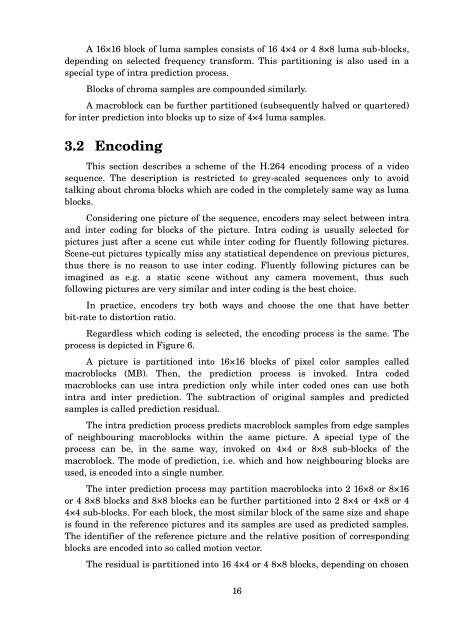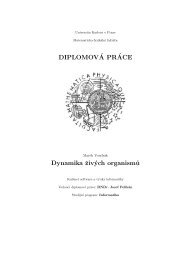MASTER THESIS Video Watermarking - Computer Graphics Group ...
MASTER THESIS Video Watermarking - Computer Graphics Group ...
MASTER THESIS Video Watermarking - Computer Graphics Group ...
You also want an ePaper? Increase the reach of your titles
YUMPU automatically turns print PDFs into web optimized ePapers that Google loves.
A 16×16 block of luma samples consists of 16 4×4 or 4 8×8 luma sub-blocks,<br />
depending on selected frequency transform. This partitioning is also used in a<br />
special type of intra prediction process.<br />
Blocks of chroma samples are compounded similarly.<br />
A macroblock can be further partitioned (subsequently halved or quartered)<br />
for inter prediction into blocks up to size of 4×4 luma samples.<br />
3.2 Encoding<br />
This section describes a scheme of the H.264 encoding process of a video<br />
sequence. The description is restricted to grey-scaled sequences only to avoid<br />
talking about chroma blocks which are coded in the completely same way as luma<br />
blocks.<br />
Considering one picture of the sequence, encoders may select between intra<br />
and inter coding for blocks of the picture. Intra coding is usually selected for<br />
pictures just after a scene cut while inter coding for fluently following pictures.<br />
Scene-cut pictures typically miss any statistical dependence on previous pictures,<br />
thus there is no reason to use inter coding. Fluently following pictures can be<br />
imagined as e.g. a static scene without any camera movement, thus such<br />
following pictures are very similar and inter coding is the best choice.<br />
In practice, encoders try both ways and choose the one that have better<br />
bit-rate to distortion ratio.<br />
Regardless which coding is selected, the encoding process is the same. The<br />
process is depicted in Figure 6.<br />
A picture is partitioned into 16×16 blocks of pixel color samples called<br />
macroblocks (MB). Then, the prediction process is invoked. Intra coded<br />
macroblocks can use intra prediction only while inter coded ones can use both<br />
intra and inter prediction. The subtraction of original samples and predicted<br />
samples is called prediction residual.<br />
The intra prediction process predicts macroblock samples from edge samples<br />
of neighbouring macroblocks within the same picture. A special type of the<br />
process can be, in the same way, invoked on 4×4 or 8×8 sub-blocks of the<br />
macroblock. The mode of prediction, i.e. which and how neighbouring blocks are<br />
used, is encoded into a single number.<br />
The inter prediction process may partition macroblocks into 2 16×8 or 8×16<br />
or 4 8×8 blocks and 8×8 blocks can be further partitioned into 2 8×4 or 4×8 or 4<br />
4×4 sub-blocks. For each block, the most similar block of the same size and shape<br />
is found in the reference pictures and its samples are used as predicted samples.<br />
The identifier of the reference picture and the relative position of corresponding<br />
blocks are encoded into so called motion vector.<br />
The residual is partitioned into 16 4×4 or 4 8×8 blocks, depending on chosen<br />
16
















